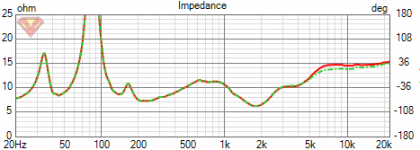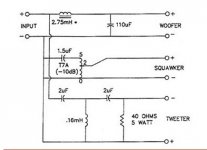On my old Klipsch Forte 2s I was looking at the crossover and had a question. The tweeter has a 40 ohm 5W resistor in the circuit but I'm puzzled over its function. I thought pad resistors had to be in series or series/parallel to the tweeter. I haven't seen a speaker run a single resistor in parallel. What does this actually do? (see attached)
Attachments
Last edited:
Cross posted in Hoffman. Suggested I post here:'
I am replacing the capacitors in a pair of Forte ii. I have Mundorf supreme 2.2uf 400v caps on hands, which I would like to use. Would there be a much of sonic difference replacing the 2uf capacitors currently being used.
I would enjoy learning how to model crossovers, to be able to play with values. Is this something available online?
thanks.
I am replacing the capacitors in a pair of Forte ii. I have Mundorf supreme 2.2uf 400v caps on hands, which I would like to use. Would there be a much of sonic difference replacing the 2uf capacitors currently being used.
I would enjoy learning how to model crossovers, to be able to play with values. Is this something available online?
thanks.
Cross posted in Hoffman. Suggested I post here:'
I am replacing the capacitors in a pair of Forte ii. I have Mundorf supreme 2.2uf 400v caps on hands, which I would like to use. Would there be a much of sonic difference replacing the 2uf capacitors currently being used.
I would enjoy learning how to model crossovers, to be able to play with values. Is this something available online?
thanks.
If the old caps are electrolytic caps, you definately should replace them with new polypropylen or polyester caps. If the old caps are age-resistant polyprop, you can keep them as is. If you update the caps so keep the same values of the caps, especially if the original drivers are used but a change from 2mf to 2,2 mf is fine.
If the old caps are polyprop, you can test with a very small "bypass" cap in parallell in order to achive a better sound. For example Vishay MKP1837 / 0,01uF MKP 100VDC is used in several places.
Humble Homemade Hifi - Capacitor Test
Last edited:
Depending on the tweeter the impedance curve can dip way below nominal level.
with higher order filters.
Parallel resistor will flatten Q at the cutoff, and also raise the impedance curve to more
acceptable levels.
I have seen " 4 ohm" nominal tweeters dip down to 1 or 2 ohms towards higher frequency.
parallel resistor raises the curve back up to 4 ohms.
with higher order filters.
Parallel resistor will flatten Q at the cutoff, and also raise the impedance curve to more
acceptable levels.
I have seen " 4 ohm" nominal tweeters dip down to 1 or 2 ohms towards higher frequency.
parallel resistor raises the curve back up to 4 ohms.
Well, that's interesting. Hmmm. Could you elaborate??I have seen " 4 ohm" nominal tweeters dip down to 1 or 2 ohms towards higher frequency.
parallel resistor raises the curve back up to 4 ohms.
Dave.
40 ohms parallel resistor will modify the shape of the tweeter frequency response by a fear amount (more than 1 dB!) and also the overall impedance. It's action can easily be seen with the crossover simulator software.The tweeter has a 40 ohm 5W resistor in the circuit but I'm puzzled over its function.
... What does this actually do?
10% difference in capacitor value should result in less than 1 dB change around crossover frequency, but it may be detectable (for better or worse).I am replacing the capacitors in a pair of Forte ii. I have Mundorf supreme 2.2uf 400v caps on hands, which I would like to use. Would there be a much of sonic difference replacing the 2uf capacitors currently being used.
I would enjoy learning how to model crossovers, to be able to play with values. Is this something available online?
There is no crossover modeling on-line possibility. You have to download and install a proper software.
It is not that simple... It will lower the complex impedance only of resistor plus driver combination (parallel summation), but how will react high-pass tweeter filter on that, producing the total loudspeaker impedance? Like this real-world example:

Dashed impedance with green color is without R=40 ohms, bold impedance with red color is with R=40 ohms parallel to the tweeter. All other crossover components are the same.
Of course, total impedance change with such a parallel resistor may be completely different with other crossover and other driver.

Dashed impedance with green color is without R=40 ohms, bold impedance with red color is with R=40 ohms parallel to the tweeter. All other crossover components are the same.
Of course, total impedance change with such a parallel resistor may be completely different with other crossover and other driver.
Last edited:
- Home
- Loudspeakers
- Multi-Way
- Purpose of resistor parallel to tweeter?
